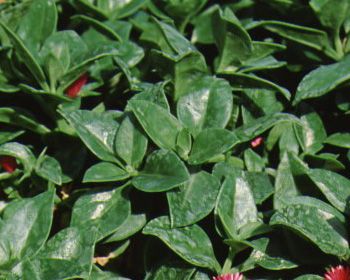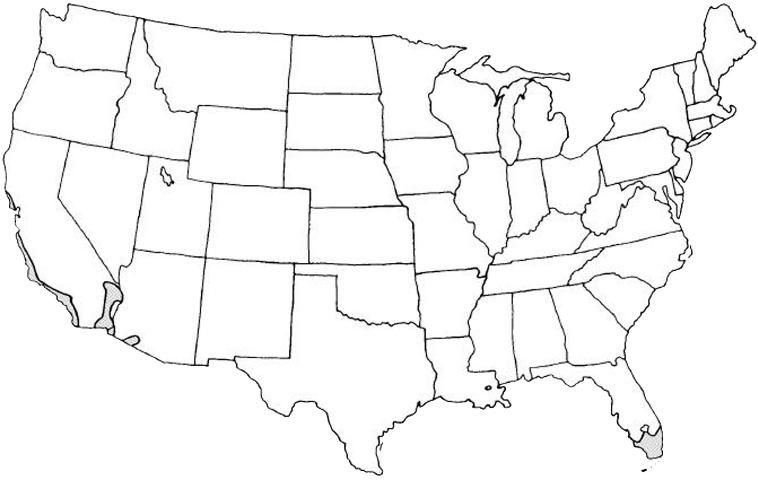Introduction
Inch-long, dark green foliage and bright red, aster-like flowers combine to make baby sunrose a spectacular hanging basket or ground cover for small, exposed, well-drained gardens. Glossy foliage sparkles in the sun forming a superb backdrop displaying the 3/4-inch blossoms nearly year-round. The moderately thick, succulent stems are flexible and easily snapped. They appear to crawl along the soil and hug the ground forming a tight, almost clipped appearance. Plants grow no taller than about 3 to 4 inches.

Credit: Edward F. Gilman, UF/IFAS

Credit: Edward F. Gilman, UF/IFAS

Credit: Edward F. Gilman, UF/IFAS
General Information
Scientific name: Aptenia cordifolia
Pronunciation: ap-TEE-nee-uh kor-dif-FOLE-ee-uh
Common name(s): baby sunrose, heartleaf iceplant
Family: Aizoaceae
Plant type: ground cover
USDA hardiness zones: 10 through 11 (Figure 4)

Planting month for zone 10 and 11: year-round
Origin: native to Africa
Invasive potential: Not considered a problem species at this time and may be recommended by UF/IFAS faculty (reassess in 10 years)
Uses: hanging basket; cascading down a wall; ground cover; mass planting
Availability: somewhat available, may have to go out of the region to find the plant
Description
Height: 0 to 1/2 feet
Spread: depends upon supporting structure
Plant habit: prostrate (flat)
Plant density: dense
Growth rate: slow
Texture: fine
Foliage
Leaf arrangement: opposite/subopposite
Leaf type: simple
Leaf margin: entire
Leaf shape: ovate
Leaf venation: none, or difficult to see
Leaf type and persistence: evergreen
Leaf blade length: less than 2 inches
Leaf color: green
Fall color: no fall color change
Fall characteristic: not showy
Flower
Flower color: red
Flower characteristic: spring-flowering; summer-flowering; fall-flowering
Fruit
Fruit shape: unknown
Fruit length: unknown
Fruit cover: unknown
Fruit color: unknown
Fruit characteristic: inconspicuous and not showy
Trunk and Branches
Trunk/bark/branches: not applicable
Current year stem/twig color: green
Current year stem/twig thickness: medium
Culture
Light requirement: plant grows in full sun
Soil tolerances: acidic; slightly alkaline; sand; loam
Drought tolerance: high
Soil salt tolerances: unknown
Plant spacing: 24 to 36 inches
Other
Roots: not applicable
Winter interest: no special winter interest
Outstanding plant: plant has outstanding ornamental features and could be planted more
Pest resistance: long-term health usually not affected by pests
Use and Management
More often grown in a hanging basket in well-drained media, its small stature and slow growth make it suited for a ground cover in a small landscape or rock garden. Locate it in front of an upright, grass or grass-like plant such as one of the ornamental grasses, African iris, or spartina to make a stunning, contrasting combination.
Be sure to locate baby sunrose in the full sun, and keep the soil on the dry side once it becomes established to prevent root rot. It is best suited for a coastal landscape where wind and sandy soil keep the soil dry. A light fertilization two or three times during the year should be all the plant needs to maintain a good appearance. After watering plants in containers, be sure to allow the media to become fairly dry before the next irrigation. Established landscape plants should require little if any irrigation in most years. Do not plant in a landscape soil unless it is very well-drained.
Design Considerations
The low-growing habit and small leaves of the baby sunrose cover the ground in a thick, lush layer of green, perfect for filling in among other plants in the landscape. Simple forms and light or medium green foliage of companion plants will highlight the dark green glossy foliage of the sunrose. Clumping plants with up-right form and larger textured leaves or strap-blade leaves would also contrast well with the matting, low-growing form. The mass of green works well with different flower colors, but bright and light colors will show the best next to the dark green foliage. Small- or medium-size flowers with simple forms will contrast with the small red flowers without adding too much detail.
Pests and Diseases
If soil is kept too moist, roots can rot, causing poor growth, chlorosis, and plant death.